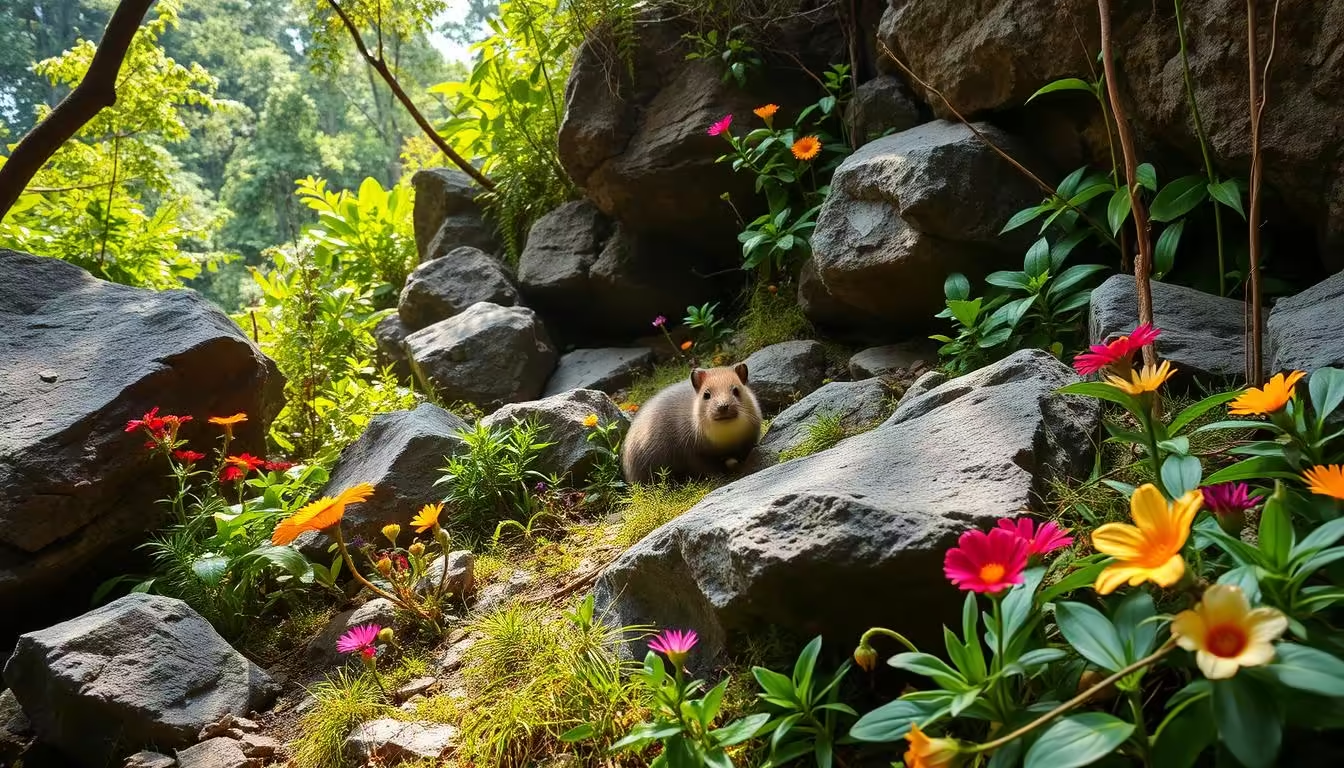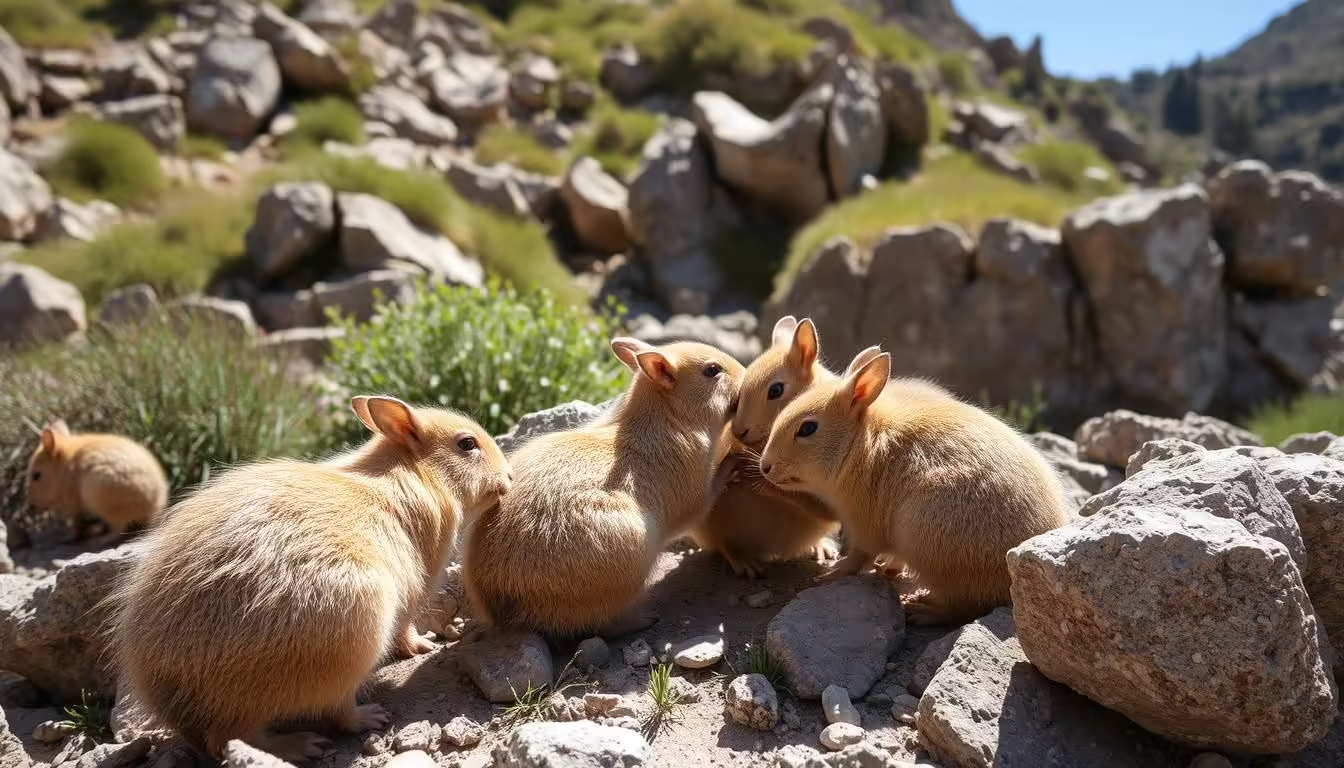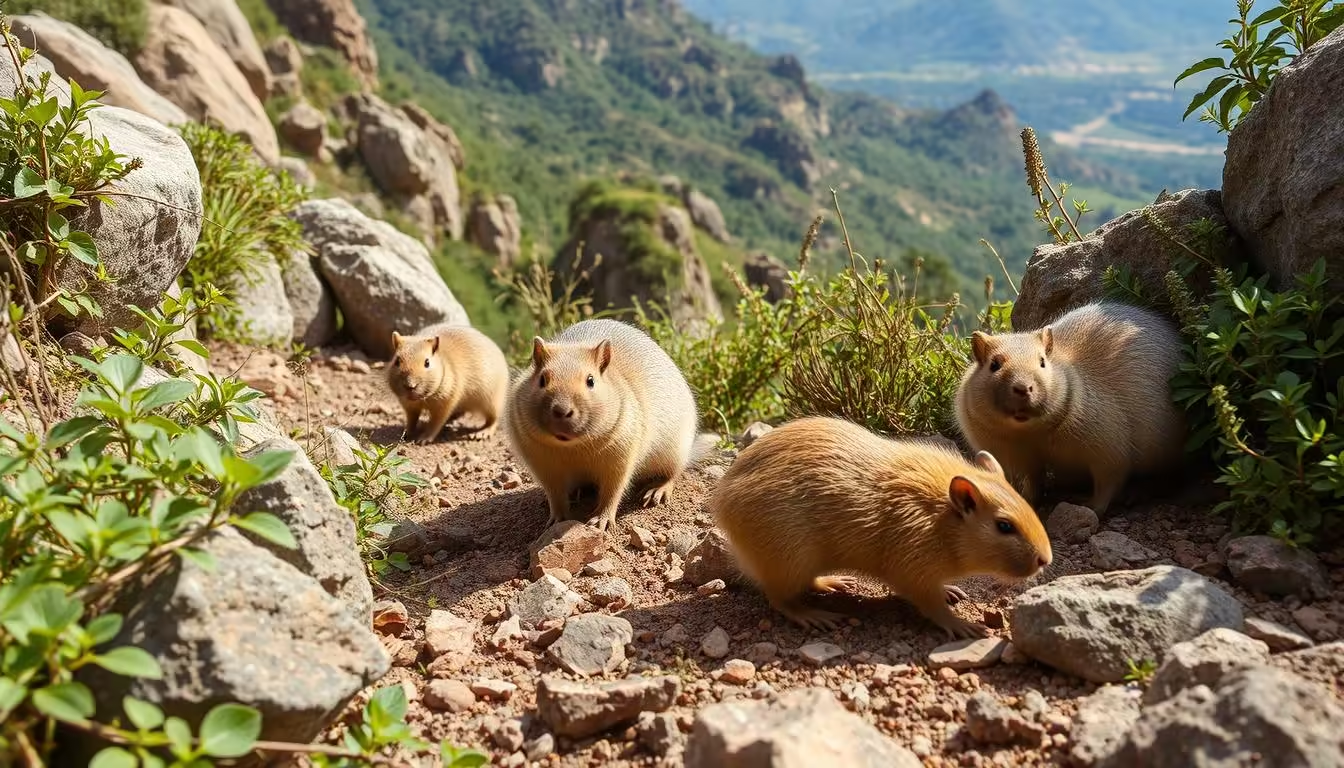In South America, the rock cavy is a small rodent that helps keep the region’s biodiversity strong. It is related to guinea pigs and capybaras. Found in different habitats, including the Caatinga biome, it plays a key role in the balance of plants and animals.
Rock cavies help plants grow by eating and spreading seeds. Their actions change the plants around them. This helps new plants grow and spread across South America.
Rock cavies are also a food source for many animals. This helps keep the ecosystem healthy. They also help the soil by moving nutrients and keeping it in good shape.
South America is facing big environmental problems like climate change and losing habitats. Rock cavies are more important than ever for keeping the biodiversity alive. We need to understand their role to protect South America’s natural wonders.
Key Takeaways
- Rock cavies play a crucial role in maintaining the biodiversity of South American ecosystems, particularly the Caatinga biome.
- Through their foraging and seed dispersal behaviors, rock cavies shape plant communities and facilitate the regeneration of vegetation.
- Rock cavies serve as a vital food source for predators, contributing to the intricate web of interactions that sustains South American biodiversity.
- Rock cavies contribute to soil health through nutrient cycling and the maintenance of soil structure, further enhancing the resilience of ecosystems.
- Preserving rock cavies and their habitats is crucial for the long-term conservation of South America’s unique natural heritage in the face of environmental challenges.
Introduction to Rock Cavies
The rock cavy is a small rodent from South America. It’s part of the Cavia genus. These animals are important for keeping their habitats diverse.
They are short and sturdy, about 20 to 25 cm long. They weigh between 700 to 1,200 grams. You can find them in grasslands, scrublands, and rocky areas. They live from sea level up to high places.
What Are Rock Cavies?
Rock cavies belong to the Cavia genus. This group has six known species. They are like guinea pigs but live in rocky areas.
They have short legs and no tails. This helps them move in steep, rocky places. Their bodies are made for these tough environments.
Physical Characteristics
- Stocky, compact bodies with short legs and no tails
- Size ranges from 20 to 25 cm in length and 700 to 1,200 grams in weight
- Fur color varies from brown to gray, often with a distinctive pattern
- Sharp, chisel-like teeth adapted for feeding on a wide range of vegetation
Habitat and Distribution
Rock cavies live in South America. They like grasslands, scrublands, and rocky areas. They can be found from sea level to high places.
Their home range goes from northern Colombia and Venezuela to central Argentina. They also live in parts of Bolivia and Peru. These rodents are good at living in different places, helping make South America’s biodiversity rich.
“Rock cavies are fascinating creatures that have evolved to thrive in the rugged landscapes of South America, playing a crucial role in maintaining the delicate balance of their ecosystems.”
Ecological Importance of Rock Cavies
Rock cavies live in the dry Caatinga region of Brazil. They are important for keeping their plant communities diverse and healthy. As herbivores, they help spread seeds, which is key to the ecosystem’s life.
Role in Seed Dispersal
Rock cavies eat many grasses and plants. They spread seeds by carrying them in their fur or digestive system. This helps new plants grow, keeping the area’s vegetation strong.
Impact on Plant Communities
Rock cavies also change plant communities by what they eat. They choose some plants over others. This affects how plants grow and live together, making the ecosystem dynamic.
Rock cavies do more than just spread seeds. They help with nutrient cycling, soil aeration, and feed predators. This shows how vital they are to their environment.
Understanding rock cavies’ role in the Caatinga biome is key. Protecting them helps keep the area’s plants and ecosystem healthy. This is important for South America’s unique regions.
Rock Cavies and Soil Health
Rock cavies, small rodents from the South American Andes, are key to soil health. They help keep the soil fertile and balanced. Their unique ways of eating and living add to the soil’s health.
Nutrient Cycling
Rock cavies eat different plants and then leave nutrient-rich poop. This poop makes the soil better for plants to grow. It keeps the soil fertile and supports the ecosystem.
Contribution to Soil Structure
Rock cavies also help the soil’s structure by burrowing. Their tunnels improve air and water flow in the soil. This makes the soil better for many living things, boosting the ecosystem’s health.
| Ecosystem Service | Contribution of Rock Cavies |
|---|---|
| Nutrient Cycling | Deposit nutrient-rich feces, enhancing soil fertility |
| Soil Structure | Burrowing activities improve soil aeration and drainage, benefiting ecosystem health |
Rock cavies keep the Andean ecosystems balanced. They show how important small animals are for the ecosystem’s health and nutrient cycles.
Social Structure of Rock Cavies
Rock cavies are small rodents from South America’s mountains. They live in close groups, showing complex group dynamics and animal communication.
Group Behavior
Rock cavies form herds of 10 to 20. This creates a community where they cooperate. They groom, touch, and play together.
These actions help keep the group strong and united.
Communication Among Rock Cavies
Communication is key for rock cavies. They make sounds like purrs, barks, whistles, and squeals. Each sound means something different.
They use these sounds to warn of danger, signal where they’re going, and keep the group together. Their way of communicating shows their smartness and ability to adapt.
“Rock cavies are fascinating creatures, their social interactions and communication strategies providing a window into the complex world of small mammal communities.”
Learning about rock cavies’ group dynamics and animal communication helps us understand their role in South America’s ecosystems.
Interactions with Other Species
Rock cavies are key players in South American ecosystems. They help keep the balance of nature. Their actions with other species, like hunting, competing, or living together, are vital for the area’s beauty.
Predation and Competition
Many animals, like mammals and birds, hunt rock cavies. To stay safe, they live in groups and make sounds to warn each other. This fight for survival is important for the area’s nature.
Rock cavies also compete with other animals for food. But, they are important for plants. Their eating and digging help other animals and plants live well.
Symbiotic Relationships
Rock cavies have special relationships with others. They help spread seeds, which helps plants grow. This helps the area’s nature thrive.
They also carry parasites, which affect the ecosystem. Knowing about these relationships helps protect the area’s nature.
| Ecosystem Interactions | Predator-Prey Relationships | Biodiversity Impact |
|---|---|---|
| Rock cavies as prey and seed dispersers | Adaptations to avoid predators, such as group living and vocalizations | Maintaining plant community diversity and overall ecosystem balance |
| Symbiotic relationships with other organisms | Potential for commensal species to influence predator-prey dynamics | Facilitating the growth and dispersal of diverse plant and animal species |
“Rock cavies are not just passive inhabitants of South American ecosystems; they are active participants in the intricate web of biodiversity that sustains these remarkable regions.”
Threats to Rock Cavies
Rock cavies, small rodents from South America, face big threats. Habitat destruction is a major issue, caused by humans. Deforestation and urbanization clear their homes for farming and buildings.
They also face climate change. Changes in weather and food availability harm their survival. These changes upset the balance of their ecosystems, making species conservation harder.
| Threat | Impact | Potential Mitigation Strategies |
|---|---|---|
| Habitat Destruction | Loss of vital resources, fragmentation of populations, and increased vulnerability to predation |
|
| Climate Change | Disruption of food and water sources, alterations in breeding and migration patterns, and increased exposure to extreme weather events |
|
To save rock cavies, we need a team effort. Scientists, policymakers, and local communities must work together. By using green land practices, protecting areas, and fighting climate change, we can protect these animals and the biodiversity they support.
Conservation Efforts
It’s crucial to protect the homes and numbers of rock cavies. One key method is setting up protected areas and reserves. These places keep the environment balanced and help rock cavies and other animals survive.
Another important part is community engagement strategies. Working with local people helps protect these small rodents and their homes. This teamwork brings in local knowledge and encourages people to care for rock cavies.
To really save rock cavies, we need long-term monitoring programs. These programs watch how populations and habitats change. They help us make better plans to protect rock cavies and their homes.
| Conservation Approach | Key Aspects | Outcomes |
|---|---|---|
| Protected Areas and Reserves |
|
|
| Community Engagement Strategies |
|
|
| Long-term Monitoring Programs |
|
|
Using these different methods, we can keep rock cavies safe for a long time. Wildlife conservation, protected areas, and community involvement all play a part. Together, we can protect these amazing small rodents and their homes for future generations.
The Role of Rock Cavies in Ecosystem Function
Rock cavies are key players in South American ecosystems. They help keep the balance of biodiversity. Their grazing changes the plants, affecting the whole ecosystem.
Grazing and Its Effects
Rock cavies eat many plants, including grasses and shrubs. They pick certain plants, changing the plant mix. This helps more plants grow, boosting ecosystem function and biodiversity support.
They keep plants from growing too much. This lets many plants thrive together. This diversity helps other animals find food and shelter, improving grazing impact and biodiversity support.
Facilitating Other Wildlife
Rock cavies help other animals by creating homes. Their burrows are safe places for many animals. This supports the ecosystem function.
- Rock cavies’ burrows are homes for small animals, helping the ecosystem function.
- Their grazing makes paths for other animals to move and find food, boosting biodiversity support.
- As food for big animals, rock cavies are important in the grazing impact and food chain.
Rock cavies help other animals live and thrive. They are crucial for the health and survival of their habitats.
Research on Rock Cavies
Recent studies on rock cavies, also known as guinea pigs, have given us new insights. They help us understand their role in South American ecosystems. Researchers are studying their population trends, habitat needs, and how they respond to their environment.
Recent Studies and Findings
In the caatinga region of Northeast Brazil, a study found 20 mammalian species, including rock cavies. Local hunters and herdsmen knew about them. This study challenges the idea that the caatinga biome has low biodiversity. The biome is huge, over 800,000 km2, but scientists have barely explored it.
Another study looked into rock cavies’ social behavior and how they communicate. They use sounds like teeth chattering to show aggression and other social signals. The study also found that female rock cavies can carry their young for up to 68 days.
Importance of Long-Term Monitoring
It’s important to keep studying rock cavy populations over time. This helps us understand their role in South American ecosystems. By tracking their numbers, where they live, and how they react to changes, scientists can create better plans to protect them.
Rock cavies are key to the caatinga ecosystem. They are food for many predators and help spread seeds and nutrients. More research and monitoring are needed to learn about their interactions with their environment. This will help preserve biodiversity in South America.
Cultural Significance of Rock Cavies
Rock cavies, also known as South American guinea pigs, are very important in many indigenous communities. They are part of local traditions, folklore, and art. This shows how much they mean in the natural and spiritual worlds of South America.
Indigenous Knowledge and Practices
Many indigenous groups in South America know a lot about rock cavies. They understand their role in nature. This indigenous knowledge includes old ways of taking care of the environment.
For example, some communities have special ways of hunting or caring for rock cavies. This ensures they can live together with these animals in a healthy way.
Representation in Local Art and Folklore
Rock cavies are often seen in local art and folklore of South America. They are symbols of fertility, strength, or cultural identity in traditional crafts. They also play big roles in stories, myths, and legends.
These stories and symbols show the cultural importance of rock cavies. They highlight the strong bond between these animals and the indigenous knowledge and South American folklore of the area.
Future Outlook for Rock Cavies
The future of rock cavies is closely tied to biodiversity conservation efforts. These unique rodents are key to the Cerrado biome’s health. But, they face threats like habitat loss and climate change.
Importance of Biodiversity Conservation
Keeping rock cavy populations safe is vital for the Cerrado’s biodiversity. They help spread seeds and nutrients, keeping the ecosystem balanced. Protecting their homes is key to conservation in the region.
Role of Scientists and Conservationists
Scientists and conservationists are crucial for rock cavy’s survival. They conduct ecological research to understand these animals better. This knowledge helps in protecting them and their habitats.
Together, we can tackle the challenges rock cavies face. A focus on ecological research and species protection will help these species and the Cerrado’s biodiversity thrive.
“The preservation of rock cavies and their habitats is not just an ecological imperative, but also a moral obligation to safeguard the rich natural heritage of the Cerrado for future generations.”
Conclusion
The rock cavies of South America are crucial for the health of their ecosystems. They help spread seeds, improve soil, and are important in the food chain. These rodents keep the balance that supports the rich variety of life in the continent.
Summary of Key Points
This article has shown how rock cavies help South American ecosystems thrive. They play a big part in spreading seeds and improving soil. Their social lives also show how connected nature is.
Call to Action for Biodiversity Preservation
It’s clear that rock cavies are vital for South American biodiversity importance. We must act now to protect them. We need to create protected areas, fund research, and involve local communities in conservation action.
By doing this, we can save these amazing creatures and the ecosystems they live in. This will help keep the biodiversity importance of South America strong for the future.



